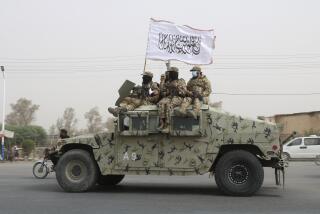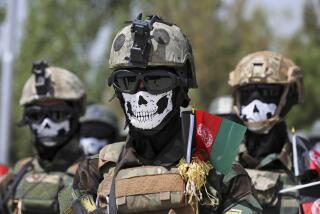Afghan dynamics altering U.S. efforts to wind down war
- Share via
MAIDAN SHAHR, Afghanistan — The story was gruesome: A university student, captured in a U.S. special forces raid, was found decapitated and with his fingers sliced off.
Amid a groundswell of public anger, Afghan President Hamid Karzai’s office cited that incident, as well as reports that nine villagers had been abducted from their homes, when he decided last week to bar the elite U.S. troops from a volatile province at the doorstep of Kabul, a move that could one day put the capital at risk.
But the account of the young man’s death was wrong, U.S. and local Afghan officials say.
He was snared by armed men, not U.S. forces or their Afghan allies, according to Afghan law enforcement officials. In police photos of the body, he has one finger chopped off and a gash on one side of his neck, but he wasn’t beheaded.
Crucially, say Afghan officials who investigated the slaying, the bearded veterinary student known as Nasratullah was a Taliban facilitator whose brother is serving time for planting so-called sticky bombs — explosives that attach with magnets. They believe that Nasratullah was killed in a power struggle between the Taliban and another Islamist faction in insurgent-ridden Wardak province, and that tribal elders here, perhaps coerced by militants, blamed Americans to fuel an outcry against U.S. troops.
If that was the case, it worked. On Feb. 24, Karzai ordered U.S. special forces to leave Wardak within two weeks.
The decision has jeopardized a counter-terrorism campaign seen as a model for a much smaller American military force that is expected to remain in Afghanistan after most U.S. troops withdraw by late next year. Commanders say the post-2014 mission is likely to rely heavily on special operations troops mentoring Afghans and carrying out operations against the remnants of Al Qaeda.
American officials are trying to persuade Karzai to reverse the order. “Obviously we would be reluctant to see our forces not able to operate there right now,” Marine Gen. James Mattis, who heads U.S. Central Command, told a congressional hearing Tuesday.
The episode also illustrates how U.S. efforts to wind down the 12-year war are being altered by local politics and an increasingly assertive Karzai, who in recent weeks has issued orders to limit coalition airstrikes and bring under Afghan control the various unofficial militias recruited by coalition forces. By pressing the U.S., the Afghan leader may be courting new alliances, including with the Taliban, while attempting to squeeze concessions from the Obama administration.
Provincial leaders in Wardak believe that the latest claims of murder and abuse by Americans and Afghans under U.S. control are being fed by the Taliban and the militant Hezb-i-Islami party, insurgent groups that have been battered by the elite U.S. forces. The Wardak leaders say Karzai acted without consulting police and intelligence officials who were deeply skeptical of the villagers’ allegations and were as blindsided by the decision as American officials.
“It made me very upset,” Haji Abdulrazaq Quraishi, the deputy police chief in Wardak, said in his office in this small, mountain-ringed provincial capital 20 miles from Kabul.
“This was not a decision based on facts,” he said. “It was a decision that will help our enemies. And it was a decision made without asking all the security sources in the province whose job it is to investigate.”
Two U.S. officials said a joint U.S.-Afghan investigation had not found evidence supporting the villagers’ accusations of mistreatment by American soldiers and allied Afghan militias.
“I am confident in saying that we didn’t cut anyone’s head off and we didn’t kidnap anyone,” said an American official briefed on the inquiry, which is expected to be finished within days. He requested anonymity in discussing the investigation, which has not been completed.
Four of the nine men that Kabul said had “disappeared” were taken prisoner in joint raids in November and December by U.S. and Afghan special operations troops, he said. They are suspected of involvement in insurgent attacks and are being held at the Parwan prison north of Kabul, the official said. The U.S. had no contact with the other five men, the official said.
Karzai demanded that the elite U.S. troops, who reportedly operate in at least three districts in Wardak even though their activities are officially classified, leave the province by Sunday. Wardak has been one of Afghanistan’s most contested provinces; in 2011, Taliban fighters here shot down a U.S. Army Chinook helicopter, killing 38 U.S. and Afghan troops, including 17 Navy SEALs.
U.S. forces in Afghanistan have been accused of abductions and abuses before, particularly the special operations forces, whose nighttime raids on suspected insurgents’ homes have long vexed Karzai. With an election for his successor due next year, analysts believe the Afghan president is facing pressure from Taliban and Hezb-i-Islami sympathizers in his government.
Ridding Wardak of special forces, the analysts argue, could represent an effort to appease the insurgents and draw them into peace talks with Kabul. Karzai recently pledged to send delegates to meet Taliban representatives in Qatar to explore talks, and a U.S. official said that Hezb-i-Islami had recently been in quiet negotiations with Kabul.
“To boost the morale of the insurgents, this decision really works,” said Abdul Rahim Khurram, deputy director of the Liaison Office, an independent research organization in Kabul. “They will feel very close to victory at least in one important place.”
Karzai’s spokesman, Aimal Faizi, rejected assertions that politics played a role in the decision, saying that the presidential palace had been receiving complaints about U.S. forces in Wardak for months.
“It’s not just one or two allegations,” Faizi said. But he did not deny the possibility that villagers had been coerced into making accusations. “With the absence of the special forces, if something happens of the same nature, we will know who is responsible,” Faizi said.
A coalition official familiar with the Wardak investigation said the complaints primarily came from members of Hezb-i-Islami, a militant group loyal to Gulbuddin Hekmatyar, a former prime minister who once aligned with Osama bin Laden. U.S. military officers met last week with villagers who complained about mistreatment and determined that many were Hezb-i-Islami loyalists.
The insurgent group is under pressure not only from U.S. and Afghan special forces but also from the Taliban and fighters loyal to insurgent leader Jalaluddin Haqqani moving into Wardak, the official said.
Villagers and Karzai’s office have provided conflicting stories about the alleged abuse, in some cases blaming U.S. commandos while at other times accusing Afghans who work for the Americans. The identities of those Afghans have not been made clear, although U.S. special operations forces and the CIA over the years have secretly recruited a tangle of local militias to fight insurgents and provide security.
Human rights advocates say these groups sometimes operate as vigilantes beyond the control of their American paymasters. But officials say they have never seen them carrying out such abuse.
“Beheadings, cutting off people’s hands and legs — this is what we see from the Taliban,” said Ramazan Ali Rasouli, a member of the Wardak provincial council, an elected advisory body.
It isn’t the first time that Afghan officials in Wardak say they have faced a misinformation campaign from militants.
About three months ago, for example, the Afghan army set up seven checkpoints along a roughly 13-mile stretch of highway that was notorious for roadside bombs. Soldiers seized more than 400 bombs in the first several weeks, said Quraishi, the deputy police chief, before tribal leaders in nearby districts began accusing Afghan soldiers of shooting civilians.
Families contended that 51 people were killed, but police found no evidence of the deaths. Still, officials in Kabul ordered the checkpoints removed. The road remains dangerous.
In January, after 17 people were killed and 21 wounded in heavy fighting between coalition forces and Taliban fighters holed up in a mosque, some tribal elders reported that North Atlantic Treaty Organization airstrikes had killed civilians. Villagers later told police that there were no airstrikes and that all the dead were members of the Taliban or relatives fighting alongside them, but that insurgents had forced them to claim otherwise, Quraishi said.
“Most of these stories come from very poor people who can’t stand up to the Taliban,” said Mohammed Hussain Fahimi, secretary of the provincial council. “The special forces are putting pressure on the Taliban, so they are putting pressure on the villagers.”
Officials worried that security would deteriorate once insurgents no longer faced the threat of special forces operations. Sitting inside the shrapnel-pocked police headquarters, Quraishi motioned through his window toward the capital barely half an hour’s drive away.
“If the special forces leave here,” Quraishi said, “the Taliban will reach the gates of Kabul.”
Times staff writer Bengali and special correspondent Baktash reported from Maidan Shahr and staff writer Cloud from Washington.
More to Read
Sign up for Essential California
The most important California stories and recommendations in your inbox every morning.
You may occasionally receive promotional content from the Los Angeles Times.












